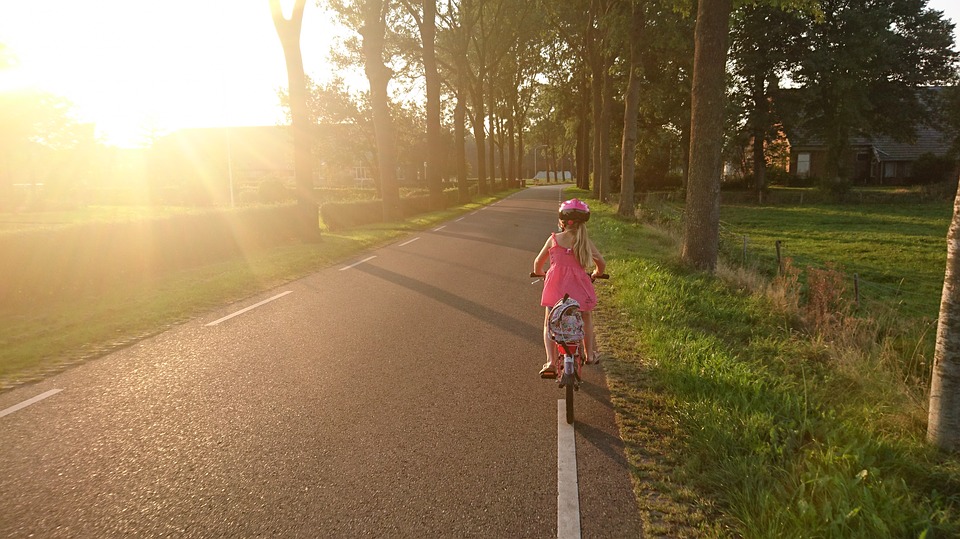
How to teach your child to ride a bike
11th May 2018
Teaching a child how to ride a bike is something that takes great patience and attention. That being said, it’s an incredibly exciting time for you both and certainly a memorable milestone that you and your child will bond over.
It can be a daunting task when teaching your child how to cycle because of course, we don’t want them to fall and injure themselves. However, when you kit them out with a helmet, knee and elbow pads, a topple off their bike won’t be a big issue. The important thing to remember when teaching your child how to ride a bike is everyone learns at their own pace. They won’t necessarily learn immediately; it takes time for them to get used to the balance and skill.
First things first, you want to know how to teach your child and we’re here to help. Below you will find the tried and tested stages that can make the whole difference.
Remove stabilisers to be able to ride the bike
If your child has already been cycling with stabilisers, it’s time to remove them so that they can learn how to ride a bike properly. The good thing about them having previously cycled on a bike is that they understand the motion of a bike and what it requires. All they need to learn now is how to keep their balance.
Choose your child’s bike
Make sure you buy your child a bike that they will be able to use, not one that they will have to ‘grow into’. An unsuitable bike can make learning to ride a bike even more challenging, so it’s important to start off with something simple and sturdy. Get the right fit for your child with a bike that allows them to stand comfortably over the top of it, with both feet firmly on the ground.
Get a fitted helmet
Safety is paramount; that’s why it’s vital that you and your child must wear a helmet when cycling. When you purchase a helmet, get one that sits securely across the forehead, nothing more than an inch above the eyebrows. Avoid helmets that rest high on the forehead or ones that budge more than an inch when the head is moved from from side to side; this means that the helmet is too big for you. Ensure that the helmet you choose can be adjusted accordingly.
Where to learn
Choosing the right place to learn is important because you want to ensure that your child is as safe as possible and have an open area with little to no obstacles. For first timers, an open grassy area is probably the best place to learn; better than stoney surfaces or tarmac which are less than forgiving when it comes to falls.
Bike preparation
- Adjust seat
- Adjust handles
- Inflate bike tyres
- Add a bell

Scooting stage
Teach your child how to scoot first. Hop over your bike, plant your bum on your saddle and use your feet to push you forwards. Make sure that they understand to have their feet ready to allow balance restoration once they have taken longer strides.
‘Woooo Weeee’
Once they get the hang of this, try to get them to gain enough momentum so that they can bring their feet completely up and onto the pedals. Remember to tell them that they must use the pads of their feet rather than the middle of them because this will save energy and also keep them prepared should they go off balance.
Stopping the bike
Show your child how to gently press on the brakes, so that they come to a gradual halt, rather than a dangerous emergency stop. Once your child is happy with how to stop their bike, try playing a game.
- Place an object a distance in front of you (try something around 15 feet)
- Use the word ‘red’ for stop and ‘green’ for go and change up the distance so that they learn to stop randomly. This gives them the skill to stop when they need to and in good time.
Don’t put pressure on them
If you put too much pressure on your child to learn how to cycle immediately, it can knock their confidence and turn a fun experience into a pressured, negative one. Make the sessions short and fun, so that they don’t get bored or stressed.
Following the leader
Once your child gets the hang of cycling, let them follow you but don’t go too far ahead. Let them overtake you every now and then and make sure that you teach them to keep their eyes open for any obstacles and other people.

At Tiny World Day Nurseries, we have a wealth of experience with children, so from day-to-day we tend to pick up a lot of knowledge when it comes to managing the typical nature and behaviour of children. This is why we’re here to share with you how best to tackle each big step you take with your child, so that you can be prepared and well equipped with rich knowledge. If you would like to know more about Tiny World Day Nursery, get in touch today and let’s schedule in a tour of our premises.

